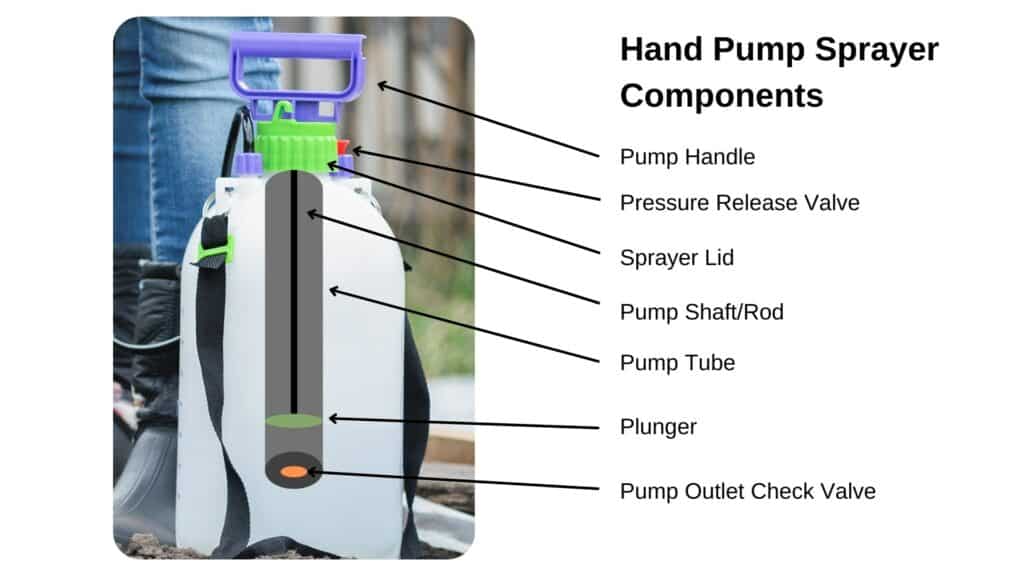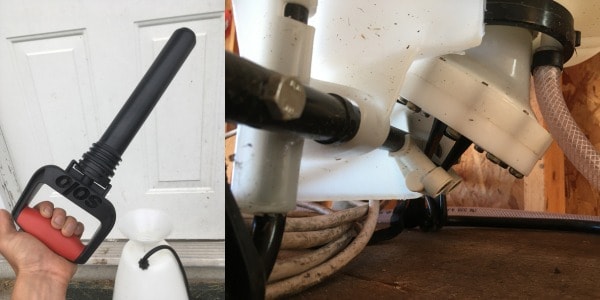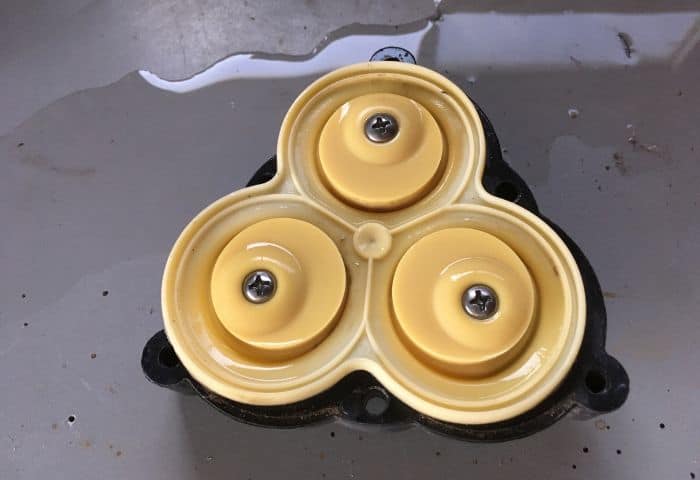A leaking sprayer can be demoralizing. Whether you are trying to use a hand sprayer or backpack sprayer, to spray your lawn or apply pesticide in your home, it gets messy. You can’t go around spraying your lawn or home dripping pesticide where it doesn’t belong. It can do damage, it’s unsafe, and it is a waste of your money.
Ultimately, a leak renders your sprayer useless once you can find a solution. You need to determine the cause of the leak and find a way to fix it. The typical causes of hand pump and backpack sprayer leaks are worn-out gaskets/seals, damaged plastic threads, and cracks in plastic tanks or wands. There are many different types of lawn & garden sprayers, let’s take a look at some common types, why they might leak, and how to fix them.
Why Does My Hand Pump Sprayer Leak?
While a leak from your hand pump sprayer is definitely an annoyance, these sprayers are simple and leaks are typically easy to identify. A leak can essentially occur as a result of damage from any component but there are some specific locations that are notorious for leaks regardless of the brand or type of sprayer.
As referenced above, hand pump sprayers are simple. They are made up of a tank, pump assembly, hose, and trigger wand. There are metal air pump sprayers but the vast majority are made of plastics. Leaks can occur at any connection point between the pump, the hose, the spray wand, and the nozzle.

RELATED: Hand Pump Sprayer Not Building Pressure?
How to Stop A Pump Sprayer From Leaking
Nozzle Leaks
One very common type of leak from a hand pump sprayer is dripping from or around the spray nozzle. This dripping can come from the nozzle itself, meaning that the valve inside the trigger wand is not working. The other type of leak from around a nozzle can come from the cap or retainer that holds the nozzle in place.
If the nozzle is leaking or dripping when you are not pulling the trigger, the valve inside the trigger is not seating properly. It may be the result of debris or residue buildup. It can also be from chemical damage. Either from normal west overtime or a chemical attack due to materials incompatible with the chemical you spray.
Video of a typical valve seat/plunger for a sprayer wand:
The valve plunger needs to seal up firmly against the seat to prevent any leaking out of the nozzle when you are not pulling the trigger. Sometimes this can be fixed by simply taking the wand apart and cleaning the valve seat and plunger. Other times the materials are worn out and need to be replaced. Some more expensive, quality spray wands will offer repair kits, but often it means getting an entirely new trigger wand.
A leak coming from around the nozzle cap or nozzle retainer can be due to a couple of things. Either the gasket/washer inside the cap is missing, damaged, or improperly installed. Alternatively, the plastic cap or wand might be damaged, typically the threads are warped or damaged.
When your spray wand is leaking from this area, you can try to replace the cap or nozzle/cap assembly and see if it seals better. The other option is to use some Teflon tape or a soft-setting thread sealer.
Connection Leaks
Like the nozzle cap leaks, any other threaded connection on the trigger valve can develop a leak. Many spray wands have a threaded connection between the trigger handle and the wand extension in addition to the nozzle and wand.
If you develop a leak in this area, the solution is often the same as with the nozzle cap leak. Use thread sealer or replace the wand completely.
Sprayer Hose Leaks
Leaks are also possible wherever the hoses are connected to the tank or wand. Hoses are typically pressed onto a fitting with a cap over the top. That cap threads onto the wand handle or the outlet on the tank. If the hose that is pressed on the fitting splits open, it may start to leak.
Obviously, a split anywhere in the hose will create a leak. It is easy to repair a hose that is split on the end that fits onto the compression fitting or barb fitting. All you need to do is simply cut off the end of the hose that has the split or leak, then push the hose end back onto the barb.
This process is easier on some sprayers than on others. Some have factory-crimped or pressed-on ends that are hard to access. Sometimes all the work and repair pieces needed just make it easier to order a new hose assembly or sprayer, depending on the quality of the sprayer that you are using.
If your hose has a leak anywhere else, you can cut out the split or hole and splice the hose back together. There are different ways to splice the hose, but using a simple hose member is very easy.
The first thing you need to do is to identify the inside diameter of your hose. Most likely it is ¼ or ⅜ inches inside diameter. Then all you need to do is to get a hose mender that fits in that size of hose. Use hose clamps to install the mender and the hose should now be tight against leaks.
In the video below, I cut the hose where the leak was and used a couple of NPT x hose barb fittings to install a male and female quick coupler. Not only did this fix the leak, but it also allows me to switch out different spray wands quickly.
Video of Sprayer Hose Repair:
Why Does My Backpack Sprayer Leak?
Backpack sprayers leek for many of the same reasons as hand pump sprayers. They both use Similar hand trigger ones and extensions that are gonna be subject to the same types of leaks from the nozzle or nozzle cap. They also have a short piece of hose that’s usually a quarter 3/8 inches inside diameter from the tank to the wand. Therefore leaks from the hose or hose connections can be dealt with in the same way that we discussed above.
One way that backpack sprayers differ from pump sprayers is that they have a bit more complicated pump assembly that creates the pressure used to propel the fluid inside. A more complex pump means more potential for leaks.

Another factor is that the pump assembly for a hand pump sprayer is enclosed inside the sprayer tank and the pump handle comes out the top of the sprayer. This means that there is little chance of leaking fluid. If the seal is bad, you will only be leaking air because of gravity.
On a backpack sprayer, the pump handle operates the piston or diaphragm on the bottom of the sprayer. If the seal, clamp, or bolts are damaged or worn out, the sprayer can potentially leak around this area. Not only does this waste product, but it makes your sprayer less effective, and it is potentially hazardous to you as it can leak onto your body.
Stopping Backpack Sprayer Leaks
Depending on the specific issue causing the leak you can often repair a backpack sprayer. For help identifying issues with your backpack sprayer not working or leaking and how to fix them please refer to this article covers troubleshooting and fixing common backpack sprayers.
Why Does My Electric Sprayer Leak?
There are many different Electronic sprayer iterations. They may be in the form of a battery-powered backpack sprayer, a 12-volt spot sprayer, or even a pull-type boom sprayer with a 12-volt electric pump. While these sprayers provide more efficiency and ease of use, they are subject to leaking like other sprayers.
One of the main things that separates these sprayers from others is the pump. A 12-volt or other battery-powered electronic pump can leak if the seal inside is worn out. Fortunately, most 12-volt sprayer pumps are pretty simple to repair. They consist of just two internal assemblies: a valve assembly and a diaphragm assembly (wobble plate).
The diaphragm/wobble plate has a lip around the outside that provides a seal keeping fluid from dripping out of the pump housing or getting to the motor. This diaphragm can wear out over time due to chemical damage, abrasion, and normal wear and tear. If you are pumping a fluid that is not compatible with the diaphragm material, it can wear out prematurely. This can lead to a leaky pump and poor pump performance.

How to Stop 12 Volt Sprayer Leaks
The fix is simple. If the motor is still good and the pump housing has no cracks, you can easily replace the diaphragm assembly. If you are experiencing any issues with a 12-volt sprayer, don’t forget to read this article on troubleshooting a 12-volt sprayer for answers.
Conclusion
A leak from any piece of equipment or appliance is annoying, but a leak from a sprayer can be a real mess and potentially hazardous. Depending on the sprayer type, the problem is usually not too hard to fix. Hopefully, with this information, you can identify the source of your leak and get your sprayer back to full function.

